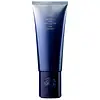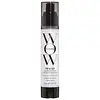What's inside
What's inside
 Key Ingredients
Key Ingredients

No key ingredients
 Benefits
Benefits

 Concerns
Concerns

 Ingredients Side-by-side
Ingredients Side-by-side

Water
Skin ConditioningCyclopentasiloxane
EmollientIsododecane
EmollientDimethicone
EmollientHydrogenated Polydecene
EmollientButylene Glycol
HumectantPhenyl Trimethicone
Skin ConditioningDimethiconol
EmollientAcrylamide/Sodium Acryloyldimethyltaurate Copolymer
Emulsion StabilisingIsohexadecane
EmollientParfum
MaskingOleth-10
EmulsifyingCyclohexasiloxane
EmollientBenzyl Alcohol
PerfumingChlorphenesin
AntimicrobialPolysorbate 80
EmulsifyingPanthenol
Skin ConditioningTetrasodium EDTA
Sorbic Acid
PreservativeSorbitan Oleate
EmulsifyingGlycerin
HumectantBis-Behenyl/Isostearyl/Phytosteryl Dimer Dilinoleyl Dimer Dilinoleate
EmollientBenzophenone-4
UV AbsorberHelianthus Annuus Seed Extract
Skin ConditioningPPG-3 Benzyl Ether Myristate
EmollientCinnamidopropyltrimonium Chloride
Styrax Benzoin Resin Extract
MaskingWheat Amino Acids
Skin ConditioningHydrolyzed Jojoba Protein
Skin ConditioningHydrolyzed Rice Protein
Skin ConditioningHydrolyzed Soy Protein
HumectantCystine Bis-Pg-Propyl Silanetriol
Skin ConditioningHydrolyzed Vegetable Protein Pg-Propyl Silanetriol
Skin ConditioningHydrolyzed Vegetable Protein
Skin ConditioningPhenoxyethanol
PreservativeKaempferia Galanga Root Extract
Skin ConditioningLeontopodium Alpinum Extract
Skin ConditioningPotassium Sorbate
PreservativeCitrullus Lanatus Fruit Extract
Skin ConditioningSodium Benzoate
MaskingCitric Acid
BufferingPotassium Benzoate
PreservativeCitrulline
Skin ConditioningDisodium EDTA
Ethylhexylglycerin
Skin ConditioningLitchi Chinensis Pericarp Extract
Skin ConditioningMoringa Oleifera Seed Extract
Skin ConditioningDisodium Phosphate
BufferingPentaerythrityl Tetra-Di-T-Butyl Hydroxyhydrocinnamate
AntioxidantBenzyl Benzoate
AntimicrobialLimonene
PerfumingLinalool
PerfumingHexyl Cinnamal
PerfumingCitral
PerfumingMica
Cosmetic ColorantCI 77891
Cosmetic ColorantWater, Cyclopentasiloxane, Isododecane, Dimethicone, Hydrogenated Polydecene, Butylene Glycol, Phenyl Trimethicone, Dimethiconol, Acrylamide/Sodium Acryloyldimethyltaurate Copolymer, Isohexadecane, Parfum, Oleth-10, Cyclohexasiloxane, Benzyl Alcohol, Chlorphenesin, Polysorbate 80, Panthenol, Tetrasodium EDTA, Sorbic Acid, Sorbitan Oleate, Glycerin, Bis-Behenyl/Isostearyl/Phytosteryl Dimer Dilinoleyl Dimer Dilinoleate, Benzophenone-4, Helianthus Annuus Seed Extract, PPG-3 Benzyl Ether Myristate, Cinnamidopropyltrimonium Chloride, Styrax Benzoin Resin Extract, Wheat Amino Acids, Hydrolyzed Jojoba Protein, Hydrolyzed Rice Protein, Hydrolyzed Soy Protein, Cystine Bis-Pg-Propyl Silanetriol, Hydrolyzed Vegetable Protein Pg-Propyl Silanetriol, Hydrolyzed Vegetable Protein, Phenoxyethanol, Kaempferia Galanga Root Extract, Leontopodium Alpinum Extract, Potassium Sorbate, Citrullus Lanatus Fruit Extract, Sodium Benzoate, Citric Acid, Potassium Benzoate, Citrulline, Disodium EDTA, Ethylhexylglycerin, Litchi Chinensis Pericarp Extract, Moringa Oleifera Seed Extract, Disodium Phosphate, Pentaerythrityl Tetra-Di-T-Butyl Hydroxyhydrocinnamate, Benzyl Benzoate, Limonene, Linalool, Hexyl Cinnamal, Citral, Mica, CI 77891
Propylene Glycol
HumectantWater
Skin ConditioningCyclopentasiloxane
EmollientHexylene Glycol
EmulsifyingPhenyl Trimethicone
Skin ConditioningDimethiconol
EmollientPhenoxyethanol
PreservativeCaprylyl Glycol
EmollientPolyacrylamide
C13-14 Isoparaffin
EmollientMica
Cosmetic ColorantParfum
MaskingEthylhexyl Salicylate
UV AbsorberLaureth-7
EmulsifyingCI 77891
Cosmetic ColorantButylene Glycol
HumectantLinalool
PerfumingHexyl Cinnamal
PerfumingCitronellol
PerfumingIngredients Explained
These ingredients are found in both products.
Ingredients higher up in an ingredient list are typically present in a larger amount.
Butylene Glycol (or BG) is used within cosmetic products for a few different reasons:
Overall, Butylene Glycol is a safe and well-rounded ingredient that works well with other ingredients.
Though this ingredient works well with most skin types, some people with sensitive skin may experience a reaction such as allergic rashes, closed comedones, or itchiness.
Learn more about Butylene GlycolCi 77891 is a white pigment from Titanium dioxide. It is naturally found in minerals such as rutile and ilmenite.
It's main function is to add a white color to cosmetics. It can also be mixed with other colors to create different shades.
Ci 77891 is commonly found in sunscreens due to its ability to block UV rays.
Learn more about CI 77891Cyclopentasiloxane, or D5, is a silicone used to improve texture of products and trap moisture.
D5 is considered lightweight and volatile. Volatile means it evaporates quickly after application. Once evaporated, D5 leaves a thin barrier that helps keep skin hydrated.
It is also an emollient. Emollients help soften the skin and prevent water loss. Silicones create a silky texture in products. D5 helps other ingredients become more spreadable.
Studies show D5 is safe to use in skincare products. We recommend speaking with a skincare professional if you have concerns.
Learn more about CyclopentasiloxaneDimethiconol is a silicone that resembles the popular dimethicone. Like other silicones, it is an emollient. Emollients create a thin film on skin to prevent moisture from escaping.
This ingredient helps to create a silky texture and improve spreadability. Due to its high molecular weight and thickness, it is often combined with cyclopentasiloxane.
Hexyl Cinnamal is a fragrance ingredient with a similar scent to jasmine. It can be naturally found in chamomile essential oil.
This ingredient is a known EU allergen and may sensitize the skin. The EU requires this ingredient to be listed separately on an ingredients list.
Hexyl Cinnamal is not water soluble but is soluble in oils.
Learn more about Hexyl CinnamalLinalool is a fragrance and helps add scent to products. It's derived from common plants such as cinnamon, mint, citrus, and lavender.
Like Limonene, this ingredient oxidizes when exposed to air. Oxidized linalool can cause allergies and skin sensitivity.
This ingredient has a scent that is floral, spicy tropical, and citrus-like.
Learn more about LinaloolMica is a naturally occurring mineral used to add shimmer and color in cosmetics. It can also help improve the texture of a product or give it an opaque, white/silver color.
Serecite is the name for very fine but ragged grains of mica.
This ingredient is often coated with metal oxides like titanium dioxide. Trace amounts of heavy metals may be found in mica, but these metals are not harmful in our personal products.
Mica has been used since prehistoric times throughout the world. Ancient Egyptian, Indian, Greek, Roman, Aztec, and Chinese civilizations have used mica.
Learn more about MicaParfum is a catch-all term for an ingredient or more that is used to give a scent to products.
Also called "fragrance", this ingredient can be a blend of hundreds of chemicals or plant oils. This means every product with "fragrance" or "parfum" in the ingredients list is a different mixture.
For instance, Habanolide is a proprietary trade name for a specific aroma chemical. When used as a fragrance ingredient in cosmetics, most aroma chemicals fall under the broad labeling category of “FRAGRANCE” or “PARFUM” according to EU and US regulations.
The term 'parfum' or 'fragrance' is not regulated in many countries. In many cases, it is up to the brand to define this term.
For instance, many brands choose to label themselves as "fragrance-free" because they are not using synthetic fragrances. However, their products may still contain ingredients such as essential oils that are considered a fragrance by INCI standards.
One example is Calendula flower extract. Calendula is an essential oil that still imparts a scent or 'fragrance'.
Depending on the blend, the ingredients in the mixture can cause allergies and sensitivities on the skin. Some ingredients that are known EU allergens include linalool and citronellol.
Parfum can also be used to mask or cover an unpleasant scent.
The bottom line is: not all fragrances/parfum/ingredients are created equally. If you are worried about fragrances, we recommend taking a closer look at an ingredient. And of course, we always recommend speaking with a professional.
Learn more about ParfumPhenoxyethanol is a preservative that has germicide, antimicrobial, and aromatic properties. Studies show that phenoxyethanol can prevent microbial growth. By itself, it has a scent that is similar to that of a rose.
It's often used in formulations along with Caprylyl Glycol to preserve the shelf life of products.
Phenyl Trimethicone is a silicon-based polymer. It is derived from silica.
Phenyl Trimethicone is used as an emollient and prevents products from foaming.
As an emollient, it helps trap moisture in the skin. It is considered an occlusive.
Learn more about Phenyl TrimethiconeWater. It's the most common cosmetic ingredient of all. You'll usually see it at the top of ingredient lists, meaning that it makes up the largest part of the product.
So why is it so popular? Water most often acts as a solvent - this means that it helps dissolve other ingredients into the formulation.
You'll also recognize water as that liquid we all need to stay alive. If you see this, drink a glass of water. Stay hydrated!
Learn more about Water